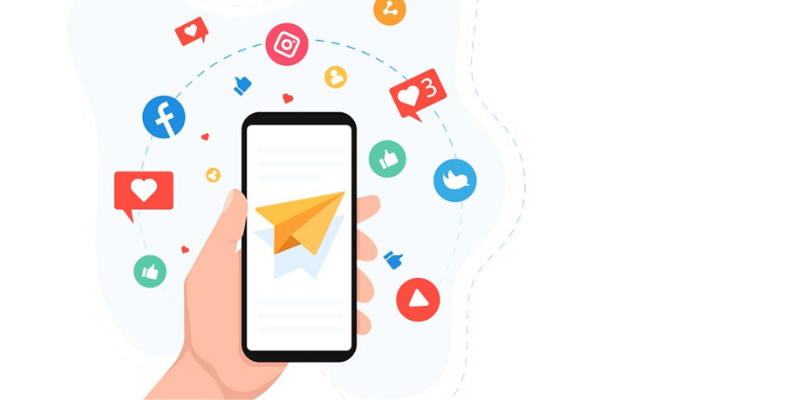Top trends of Social Media in 2020

Complete SEO Checklist For 2020
May 13, 2014
List of SEO Tools to use in 2020
May 30, 2020In the last decade, we have observed that more than 560 million people in India are active daily on different social media channels. To cultivate the audience, brands today are tasked to make sense of their social data while also finding different ways to engage with them. But, social media is far from static, what worked yesterday may not work today. Technology changes, platforms evolve and new practices become the highlight of the season. With this in mind, we have predicted a few trends for 2020 that every marketer should know.
Rise of alternative platforms:Facebook, Instagram & Twitter have seen a drop in the users, especially the younger audience in 2019. While TikTok which started in 2016 has seen 500 million active users worldwide in 2019. It may not be the best option for B2B but it is earning good two-way engagement for B2C brands. Brands in India are now looking for more avenues to promote their products and offers by UGC & TikTok appears to be worth the time and money to explore. Let’s take a look at how different brands have explored it in India -
#SwagStepChallenge By Pepsi India
On the craze for cricket and dance during #CricketWorldCup. Through this campaign, they asked the audience to match the dance step of the influencers - Tiger Shroff and Disha Patani. The hashtag was able to earn 17 billion views on the platform. They were able to leverage crowdsourcing and UGC through the platform.
#BigBillionStar by Flipkart
To promote the big billion sale, Flipkart leveraged the UGC platform by asking people to create a duet video alongside the brand ambassadors of the brand - Virat Kohli, Amitabh Bachan, MS Dhoni & Alia Bhatt. The campaign got more than 8 billion views on the platform.
Now that you got an idea of how brands are leveraging TIKTOK, let’s take a look at how Pinterest, with 320 million monthly active users is becoming the first choice for marketing eCommerce products.
Pinterest is becoming a place that aspires the audience by sharing ideas to spend on all the visually appealing products (Fashion, Food, Accessories, Experiences. Interior.) In recent days, Pinterest has rolled out ‘Shop the look’ ads, you can add 25 images to check out the look and there will be a ‘Shop’ button which allows you to directly purchase from the business profile, now that’s interesting! We will be seeing a lot more virtual reality updates on this front in 2020.
Go Glocal:Yes, you read it right, it’s not a typo. With internet on the hand, any brand can go global but recent shifts show that brands are not going global but they are going glocal, It means that companies are thinking globally but with a local touch (customization) to resolve the need of the consumer. Glocal companies work on the strategy where they are giving a global appeal with an intimate experience of a local brand.
In the internet age, marketers are not just changing the language but they analyze the local market and change their social strategy, connect with influencers who can bring conversation among the audience about the brand, even changing their global advertisement according to the local taste. Brands like Bournvita, Red label tea give their advertisement a local taste with changing not only the language of the ad but also connect with nano influencers for a better and specific audience like women. If you are still thinking of planning your next strategy, we suggest you go glocal, bring some local taste, it can be through language, festivals, ads, influencers anything.
Is influencer marketing still working?
Most brands indulge in influencer marketing to gain visibility followed by sales/leads and lastly to generate more content, they on average engage with 5-10 influencers in a quarter. Initially, when influencer marketing started, companies used to engage with influencers who have big followers, but now that we know, followers can be purchased, therefore managers do their thorough research based on the quality of posts and engagement on it. Companies are moving from Macro and Micro-influencers to Nano influencers for more authentic followers and engagement. Recently for marketing GoodNewz movie, they connected with Nano Mom bloggers and did some giveaways, polls and also promotional posts. Which gained a lot of positive engagement towards the movie. Not just that, casual purchase categories like fashion, jewellery, lifestyle, smartphones, etc. all the brand’s products that do not require a big amount of investment are not preferring nano influencers compared to celebs.
These social media influencers have less than 3000 followers and most of them are known to the influencers. There are different brands who run college ambassador programs, where they connect with the students who can influence and can bring real value for the brand through interactive engagements.
“The purpose of using nano-influencers like students over celebrities is that of creating varied social media content. A celebrity’s post that is promoted on social media earns lower engagement than that of several posts by people with fewer followers,” points out Jiten Mahendra, VP Marketing, Max Fashion.
Still, one of the major problems the brands faced is to calculate the ROI. They all are ready to increase the budget but now with vanity metrics gone they all want to know how to calculate ROI. Even in Talkwalker’s report, many marketing managers have talked about the same.
2020 for influencers will be a year of value and accountability. It will be about driving association and exclusivity and most importantly understanding the ROI from them, which could be in terms of brand value and actual business. We are trying influencer marketing for Diwali, 2019 and we plan to allocate more budgets in 2020.
Gaurav Midha,Senior Marketing Manager
Tanishq
The ROI on influencer marketing should be calculated on multiple criteria:
Investment on influencers compared to the cost of acquisition.
Investment done on influencers compared to investment done by a brand to achieve the same amount of engagement through other media
We suggest you try these methods and tell us how positive or negative influencers are affecting your brand.
Less emphasis on “vanity metrics”:
We talked about the Vanity metrics before also in the blog but before going into details, let’s first understand what Vanity Metrics is and why it is not needed now. Earlier, all brands were looking for more likes, followers, subscribers, and views per post which are vanity metrics, but now the algorithm of platforms is changed, millions or billions of followers are not required but if brands are able to have a conversation with the audience is what counts. With the recent development in Facebook-owned platforms like Instagram testing with removing likes, the era of reporting vanity metrics is about to end. As the ad spends on them is increasing brands should start looking for more specific and detailed analysis. Metrics like share, comments, retweets, clicks, which will help you analyze the sentiment of people is the need of the hour. This way you might be able to reach the right market at the right time.
Conclusion:These are the biggest social media trends of 2020. If you are able to implement these trends into your brand strategy and you will see the rise in your overall targets.


